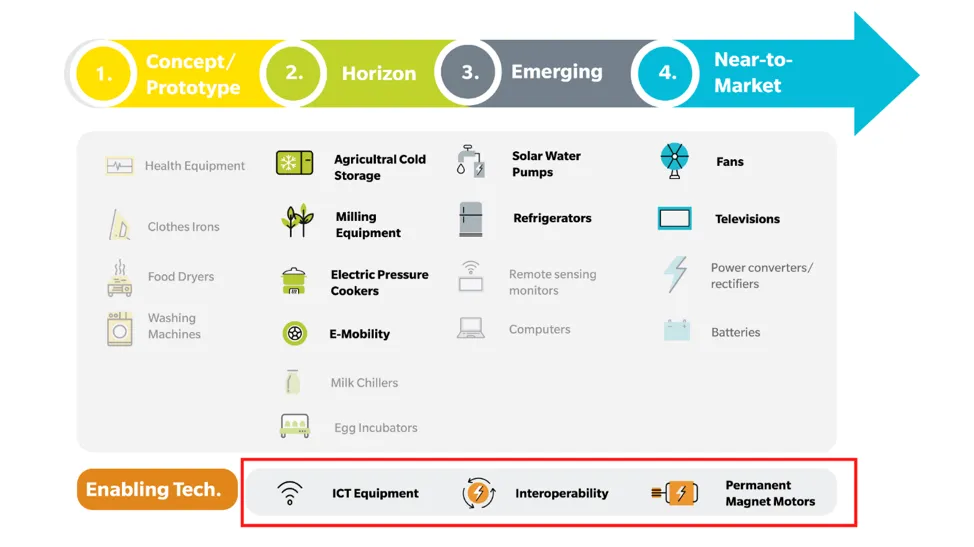Are Enabling Technologies the Key to Scaling Modern Energy Services for the Off-Grid Market?
In this blog, we explore the opportunities and challenges of adopting “enabling” technologies such as information communications technology (ICT), interoperability and permanent magnet motors (PM motors) to support the broad scale-up of the off-grid appliances market

By Chris Beland and Théo Schuhmacher (Energy Saving Trust), Michael Maina and Monica Wambui (CLASP)
This blog is the final installment of a four-part series featuring key findings from Efficiency for Access’ 2021 Solar Appliance Technology Briefs. This series provides a synthesis of cross-cutting trends for 11 off-grid appropriate appliances, equipment and enabling technologies, grouped by relative market maturity. Category groupings include near-to-market appliances (TVs and fans), emerging appliances (SWPs and refrigerators), horizon appliances (electric pressure cookers, cold storage, milling equipment and e-mobility) and enabling technologies (permanent magnet motors, information communication technology, and interoperability).
In this blog, we explore the opportunities and challenges of adopting “enabling” technologies such as information communications technology (ICT), interoperability and permanent magnet motors (PM motors) to support the broad scale-up of the off-grid appliances market. ICT equipment includes all technologies that enable communication, while interoperability refers to technologies enabling appliances to operate in the same environment and interact with no adverse effects. PM motors are a type of electric motor that promise to be more efficient than their more common counterpart, induction motors. We categorise these products as “enabling” technologies because they have the potential to catalyse the uptake of a range of appliances in off- and weak-grid settings across the market development curve (Figure 1). Many of these technologies are not novel concepts and are commonly employed in other applications. For example, USB technology was introduced in 1995 to standardise connections enabling interoperability, or compatibility, for personal computers. PM motors are widely used in on-grid white goods such as refrigerators and washing machines. Applying these technologies to off- and weak grid appliances will require a custom approach that addresses the sector’s structure and unique barriers.

Understanding Enabling Technologies and Their Growth Potential
Household appliances have become a major driver for the off-grid solar sector. The global addressable market for off-grid household appliances is an estimated USD 12.6 billion, with the potential to reach USD 25.3 billion by 2030. Interoperability, ICT and PM motors are central to this transition.
Improvements in interoperability would allow customers wishing to upgrade their system or add an appliance to their household to not have to do so through the company that sold them their solar energy kit. The predominant model is that of non-interoperable systems which use brand-specific connectors combined with proprietary digital protocols. Efforts to achieve interoperability and interconnection are nascent. Current successes in the sector include industry movement towards standardization such as Efficiency for Access’ Compatibility and Interoperability Technology Roadmap and GOGLA’s Connect White Paper, which defines a universal connector and firmware for 12 volt (V) solar home system (SHS) kits and appliance interoperability. There are also concerted R&D efforts by the private sector on topics such as device-to-device compatibility, product PAYGo compatibility and smart load management.
Widespread adoption of interoperability would have multiple benefits. It is estimated that adopting a standardised communication protocol across 25 appliances would lead to an estimated USD 1.5 million saving for the industry. Interoperability would also reduce e-waste and contribute towards achieving UN Sustainable Development Goal 7 by merging the main grid with distributed energy systems, including mini grids and solar home systems. Interoperability can also ensure that appliances are well functioning across an array of different energy systems.
ICT is a broad term that covers technologies that enable communications — such as radio, television, mobile phones, computer and network hardware, satellite systems, and internet of things (IoT)– and the services provided through these devices. ICT can also enable the uptake of other appliances highlighted in the brief series, for example, the integration of IoT to support remote monitoring and management of such appliances, contributing to improved appliance efficiency and affordability. Access to mobile phones has been a key enabler in the mobile money-driven PAYGo SHS sector, helping off-grid communities gain access to electricity and contributing to SDG7.
ICT in off- and weak-grid markets are at different stages of development. Radios, for example, have an established market presence, while computers and health-related ICT remain nascent. Radios are typically sold alongside solar home systems; more than 225,000 radios were sold globally in the first half of 2020. Computers, on the other hand, are in the growth phase in emerging economies. Most people in these markets access the internet through mobile phones. In 2019, it was estimated that only approximately 8% of households had a computer in Africa. The Efficiency for Access Research and Development Fund has supported the development of a solar-powered computer in Madagascar. Finally, health-related ICT has the potential to transform rural health access. As the momentum grows for the need to electrify health centres in the wake of COVID-19, ICT can play a key role that can improve access to care and medical information and improve diagnosis. Health-related ICT is at an early stage in the market development curve, but the need for such management and diagnosis tools could see significant growth.
PM motors can play a crucial role in addressing efficiency-related challenges in resource-constrained settings across the full grid spectrum. Motors are the primary movers in almost all machinery and appliances. PM motors can be used with smaller power supplies, tolerate low or fluctuating voltages and have longer run times due to higher efficiency. Ideal applications for PM motors in solar appliances include solar water pumps, fans and refrigerators. A case study in Pakistan revealed that a customer who purchased a pedestal fan with a brushless DC motor (a type of permanent magnet motor) from Harness Energy saw a reduction of his electricity bills from USD 21 to USD 13 within two months of owning the fan at his furniture shop.
PM motors are commonly used in on-grid white goods like refrigerators; washing machines; heating, ventilation and air conditioning (HVAC); electric vehicles and industrial applications. However, in off- and weak-grid settings, penetration is asymmetric across key appliance categories and markets. For air conditioners, PM motor penetration in South Asia was estimated to be 65% compared to 21% in Sub-Saharan Africa in 2020. Estimates for solar water pumps indicate a larger uptake, with 60% penetration in both markets.
Moving Forward: The Critical Role of Enabling Technologies
As we strive to ensure all households have access to high-performing appliances, enabling technologies will play a crucial role. Key recommendations to address current market and technological barriers include:
Promoting innovation and research and development: Continued innovation and development of enabling technologies is crucial to improve the efficiency and affordability of appliances and promote interoperability in off-grid appliances. Providing funds, grants or incentives for R&D, manufacturing, new start-ups and innovations can help technologies scale.
Building a strong knowledge base through research: Actors need more data to demonstrate the benefits of these enabling technologies. Reliable data on appliance energy savings and interoperability with other technologies such as PAYGo systems can be used to promote the integration of enabling technologies in off- and weak-grid appliances.
Encouraging demand aggregation and bulk procurement: These initiatives can help reduce the high upfront costs of PM motor-based appliances and ICT integrated devices. Bulk procurement models reduce fixed costs (i.e., manufacturing and distribution costs and sales overheads) and lower bulk prices by 20–40%. Demand aggregation through select target customer segments, such as government and co-operative societies, can significantly reduce the cost of appliances leveraging enabling technologies like PM motors.
Converging industry and building consensus on interoperability: Standardization risks and operational constraints of energy systems providers and appliance manufactures may result in a reluctance to adopt a common interoperability vision. However, collaboration can help define common specifications, achieve industry consensus and set a starting point for a transition to a more interoperable market.
For more insights on ICT equipment, interoperability, PM motors and the off-grid appropriate appliances they can positively impact, please see our full collection of long-form technology briefs and snapshots. We also encourage you to read our full synthesis report, which summarises the state of play for the entire off-grid appliances market.
***
About the 2021 Solar Appliance Technology Brief Series
The 2021 Solar Appliance Technology Briefs synthesise the latest market intelligence and chart the pathway to commercialisation for 11 disruptive technologies, including refrigerators and SWPs. New collections of technology briefs will be released monthly from May 2021 through August 2021, with groupings based on our assessment of their market maturity level. Each release will include a summary blog post, highlighting key similarities and differences across the featured technologies and the interventions needed to scale. Category groupings include near-to-market appliances (TVs and fans), emerging appliances (SWPs and refrigerators), horizon appliances (electric pressure cookers, cold storage, milling equipment and e-mobility) and enabling technologies (permanent magnet motors, ICT equipment and interoperability).